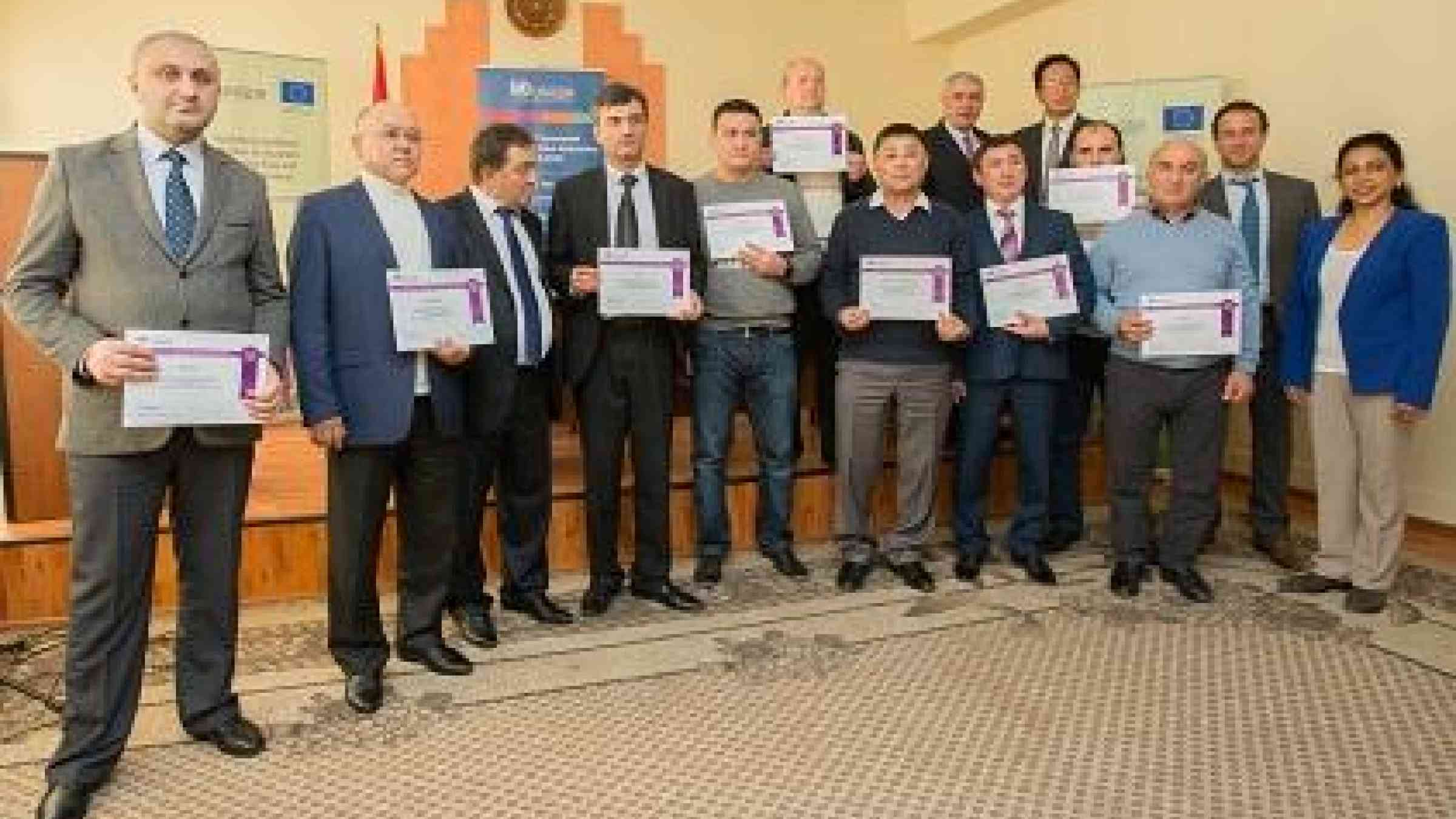Regional role model spurs cities in Central Asia, South Caucasus

Delegates at the meeting in Stepanavan mark the Making Cities Resilient campaign entry of Berd, Noyemberyan and Tumanyan in Armenia; Tbilisi and Gori in Georgia; Bishkek and Karakol in Kyrgyzstan; and Ust-Kamenogorsk and Ridder in Kazakhstan (Photo: UNISDR)
STEPANAVAN, Armenia, 12 November 2015 – A global campaign that unites almost 3,000 cities dedicated to reducing urban disaster risk has sharpened its focus on Central Asia and the South Caucasus thanks to a regional role model.
The move marks a key step in the development of Making Cities Resilient campaign, launched by the UN in 2010. The flagship programme has grown into a worldwide grouping of 2,850 communities, and the numbers are expanding apace.
Stepanavan, a city of some 20,000 people 140 kilometres north of Armenia’s capital Yerevan, has been a regional driving force. In recognition of its work, it was named a Role Model City earlier this year, and played host on Thursday to an entry ceremony for new members from elsewhere in Armenia, as well as from Caucasus neighbour Georgia and Central Asian states Kazakhstan and Kyrgyzstan.
“We’re aware that our Role Model City status is not just a matter of pride. It has also given us a lot of responsibility for the future,” said Mr. Mikayel Gharakeshishyan, the Mayor of Stepanavan.
“Today is a true milestone in our work. I hope that other cities will learn from our experience, and also give us an opportunity to share and learn from them in turn,” he added.
Set on a plateau dominated by the Caucasus Mountains, Stepavanan faces a plethora of hazards.
It suffered heavy damage during the 1988 earthquake that devastated the city of Spitak, 50 kilometres to the southwest. Other threats include landslides, fire and strong wind.
Underlining that, delegates travelling to Thursday’s ceremony from a meeting in neighbouring Georgia were delayed for hours after fallen trees blocked roads, and the city was hit by a power outage when overhead cables were brought down. Unexpected snow and ice on mountain passes held up others who drove from Yerevan, among them UN Resident Coordinator Mr. Bradley Busetto, of the UN Development Programme (UNDP).
"We all acknowledge that disaster risk reduction cannot be addressed without joint efforts of the government, international organizations, civil society and, certainly, citizens of Armenia. I am happy to highlight that Armenia has made great progress making its population more resilient to the impact of disasters over the past ten years," Mr. Busetto said in Stepanavan.
A total of 21 local government entities in Armenia are now mmembers of the Making Cities Resilient campaign, thanks to the efforts of the UN Office for Disaster Risk Reduction (UNISDR), UNDP's Armenia team and the country's Ministry of Territorial Administration and Emergency Situations.
Nine new members formally joined the campaign at the ceremony in Stepanavan: Berd, Noyemberyan and Tumanyan in Armenia; Tbilisi and Gori in Georgia; Bishkek and Karakol in Kyrgyzstan; and Ust-Kamenogorsk and Ridder in Kazakhstan.
All but Tumanyan were prepared for membership by the Resilient Cities Project in Central Asia and the South Caucasus, which began in October 2014 with funding from the European Commission's Humanitarian Aid and Civil Protection Department (ECHO).
Urban areas are a major emphasis of the Sendai Framework for Disaster Risk Reduction, a 15-year agreement adopted by the international community in March this year to curb global disaster deaths, the number of people affected and the scale of economic losses.
The Sendai Framework is the most risk-focussed blueprint to date in a process that over recent decades has seen a shift from viewing disasters purely as a matter of relief operations to a pre-emptive and sustainable development approach.
“Cities are the front lines in dealing with disasters,” said Mr. Jerry Velasquez, Chief of Advocacy and Outreach at UNISDR.
As population magnets and economic drivers, cities are particularly vulnerable to increasingly frequent and extreme weather hazards such as storms, climate change impacts including water shortages, environmental degradation and unsafe construction in seismic zones.
“Our most important task is to create cities that stand up to these risks,” said Mr. Nikolay Grigoryan, Deputy Head of the Rescue Service of Armenia.
Self-assessment according to a series of benchmarks known as the Ten Essentials lies at the heart of the Making Cities Resilient campaign, along with sharing best practice among participating cities. Areas under scrutiny include a city’s budget, how critical infrastructure is handled, policies to ensure all members of the community are included in risk planning, the safety of schools and health facilities, risk-compliant building regulations and land use, protection of ecosystems, and early warning systems.
Stepanavan only joined the campaign in 2014, but has successfully launched efforts to mobilize the population and all arms of the administration in the cause of disaster risk reduction.
Among its steps are training programmes, risk assessments, and multi-year resilience planning, the creation of what are known as Community Resilience Teams, as well as linkages with Armenia-wide bodies such as the Disaster Risk Reduction National Platform. The city has also set risk reduction planning squarely within in sustainable development projects such as energy-efficient lighting, tree planting, kindergarten refurbishment with solar heating and insulated windows.
“You could say that we’re doomed to success. All development means new risks that need tackling. And only the doers will achieve success,” said Mr. Movses Poghosyan, Director of the Disaster Risk Reduction National Platform.
Explore further
Also featured on
Is this page useful?
Yes No Report an issue on this pageThank you. If you have 2 minutes, we would benefit from additional feedback (link opens in a new window).